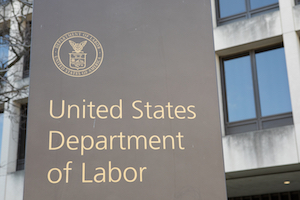 The Department of Labor (DOL) in its budget proposal for fiscal year 2024 seeks funding to implement SECURE 2.0, and that includes retirement-related priorities.
The Department of Labor (DOL) in its budget proposal for fiscal year 2024 seeks funding to implement SECURE 2.0, and that includes retirement-related priorities.
The DOL seeks $4,672,000 to Implement SECURE 2.0. The DOL indicates that it has no choice but to do so.
The Consolidated Appropriations Act of 2023, notes the DOL, included mandates for implementing SECURE 2.0, and that included “a wide range of retirement-focused issues.” However, they add, the Act “did not appropriate any additional resources for implementation.”
SECURE 2.0 “includes a broad collection of amendments to existing law and new provisions focused on increasing retirement savings, improving rules governing the administration of retirement plans, and lowering the cost of setting up retirement plans,” says the DOL. Some of the SECURE 2.0 provisions that are retirement-related are in effect already, says the DOL, but others will go into effect in 2024, 2025, and later years. The DOL notes that it is “tasked with conducting studies, submitting reports to Congress, establishing a database, opening initiatives, issuing multiple regulations, providing other formal guidance, and consulting with the Treasury Department/IRS and PBGC on various regulatory/sub-regulatory projects assigned to those agencies.”
Among the retirement-related projects the DOL seeks to fund with the more than $4 million are the following:
- In consultation with the Secretary of the Treasury, create and maintaining an online searchable database that allows retirement savers who have lost track of their retirement plan to search for the contact information of their plan administrator to make a claim for benefits. This also involves related data collection.
- Develop and issue guidance and regulations for a prohibited transaction exemption for certain automatic portability transactions intended to accomplish two goals — (1) reduce leakage of retirement savings out of ERISA plans and (2) help address missing participant issues — through a system that automatically rolls over retirement savings to a new employer’s plan when employees change jobs.
- Provide implementation and compliance assistance guidance for plan sponsors and employees regarding the addition of newly authorized emergency savings accounts to the retirement plans offered to employees. This includes implementing collections of information for purposes of (1) oversight and (2) providing a mandated report to Congress.
- Conduct a review for purposes of (1) reporting to Congress and (2) implementing multiple reporting and disclosure provisions, including new disclosure requirements for defined benefit and defined contribution retirement plans covered by ERISA, as well as provisions relating more generally to effectiveness, simplification, and consolidation of retirement plan disclosures.
- Conduct a review of the DOL’s Interpretive Bulletin concerning fiduciary standards under ERISA applicable to the selection of an annuity provider for the purpose of benefit distributions from a DB plan when it intends to transfer liability for benefits to an annuity provider. The review is to include a determination of whether amendments are warranted; the DOL is to report to Congress on the findings of the review, including an assessment of any risks to participants.
- Log in to post comments
